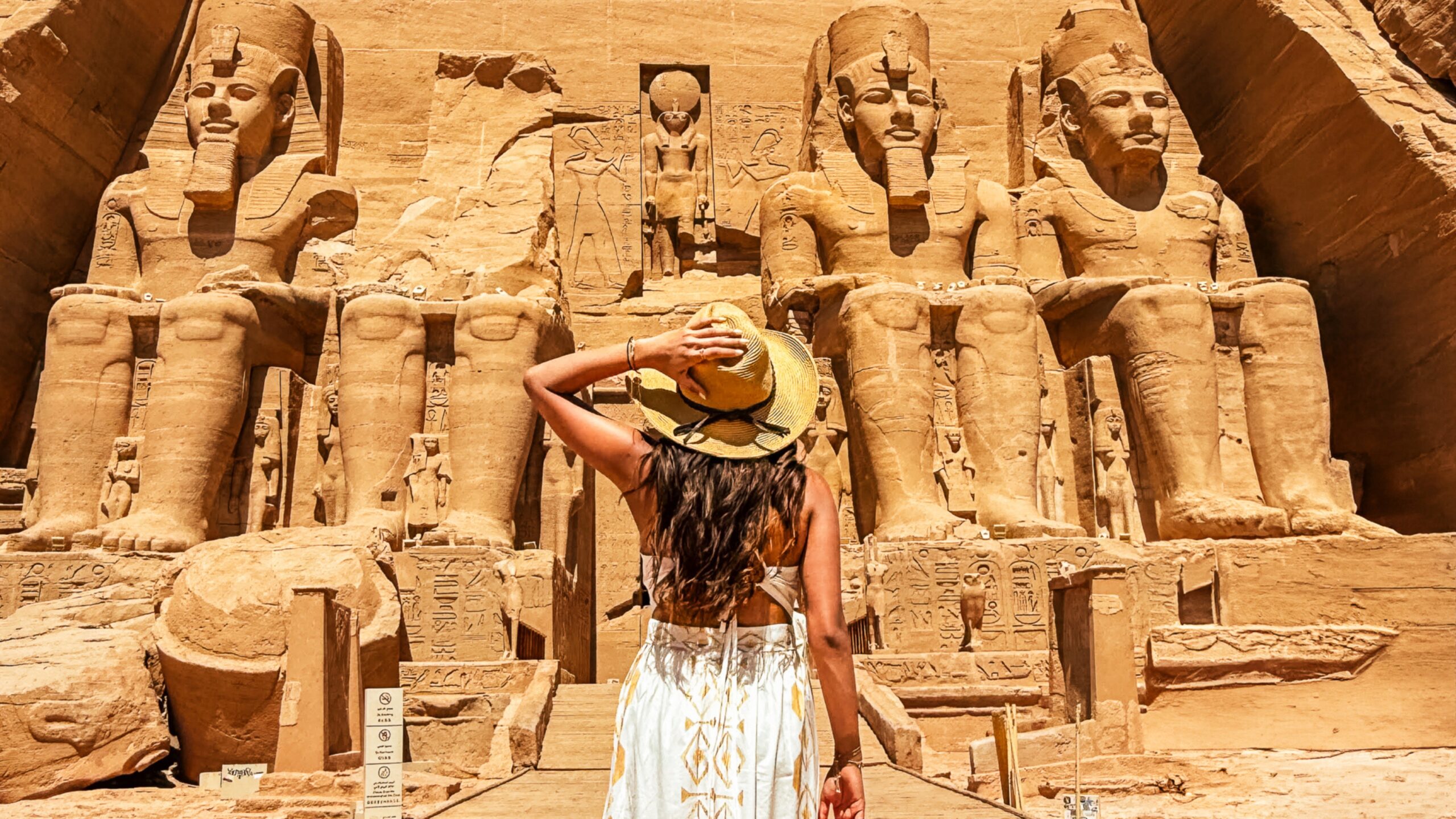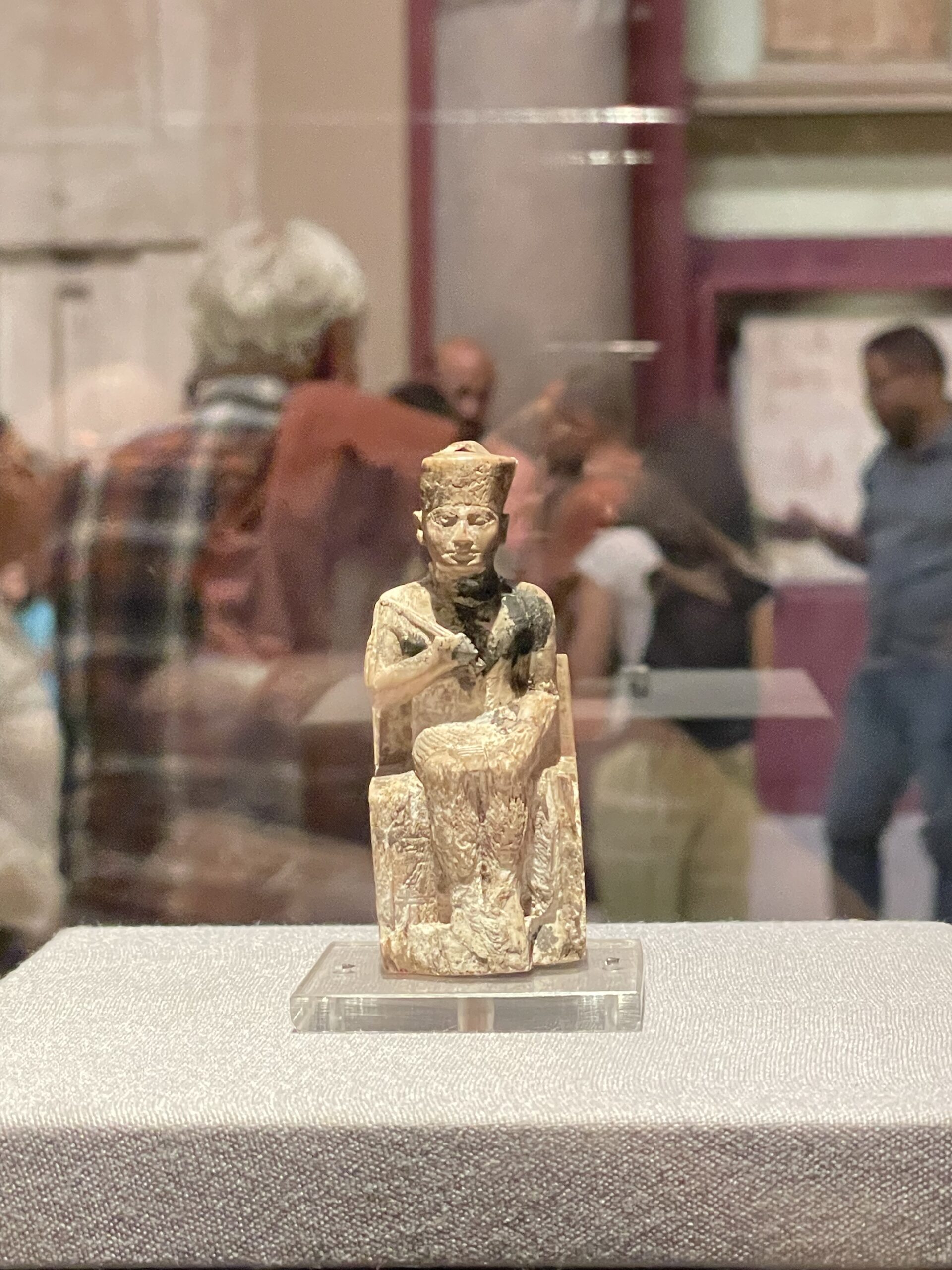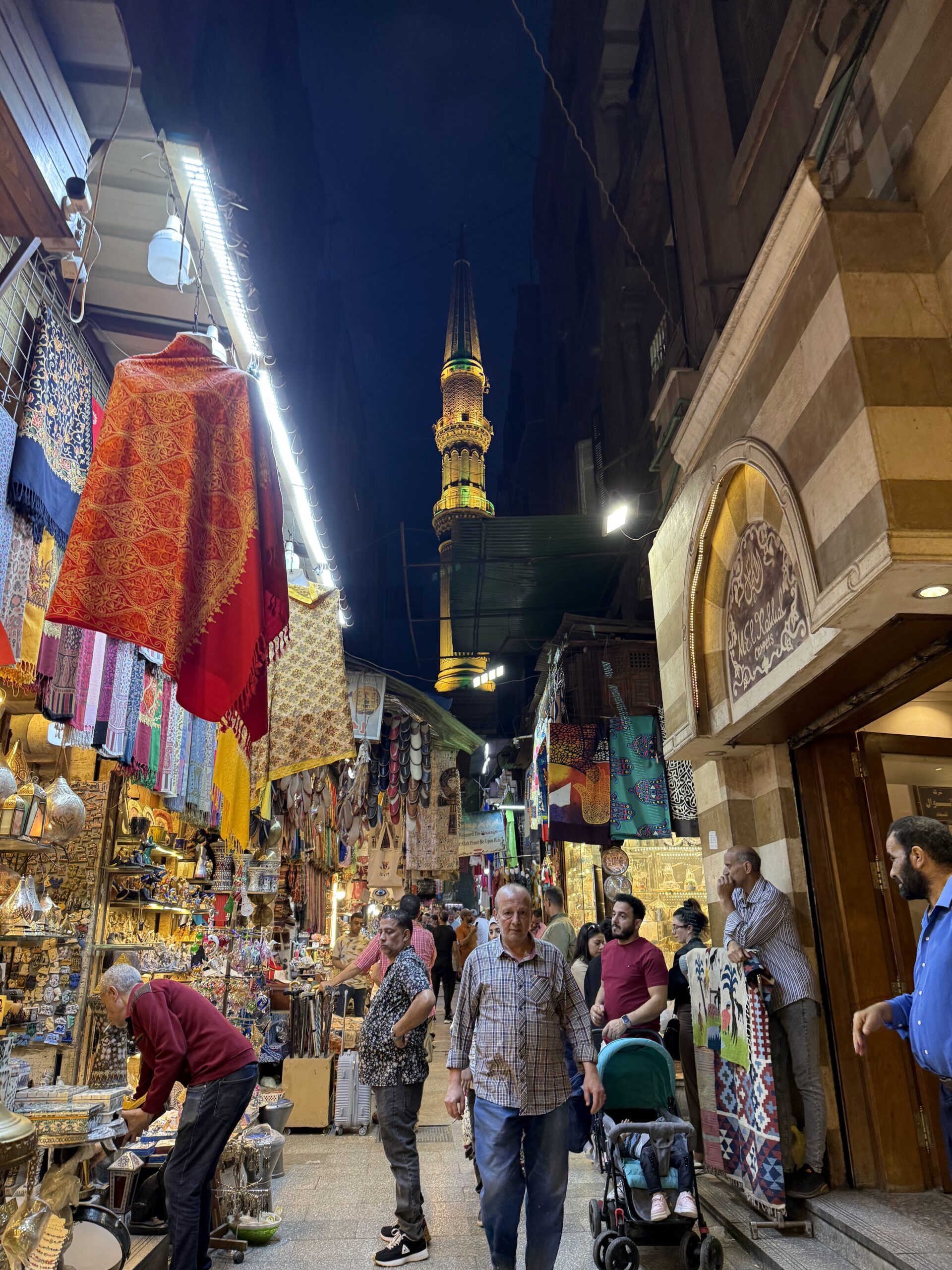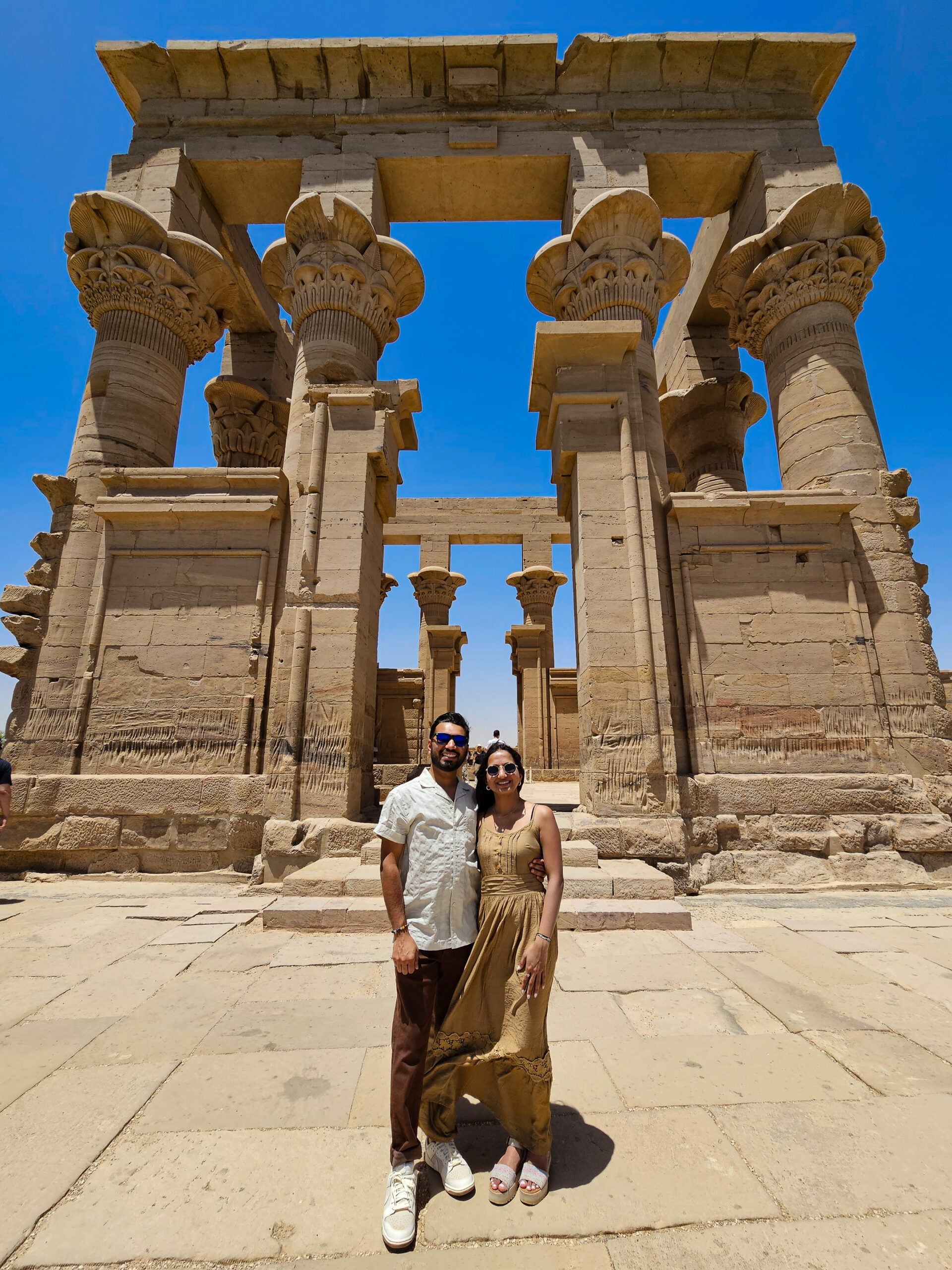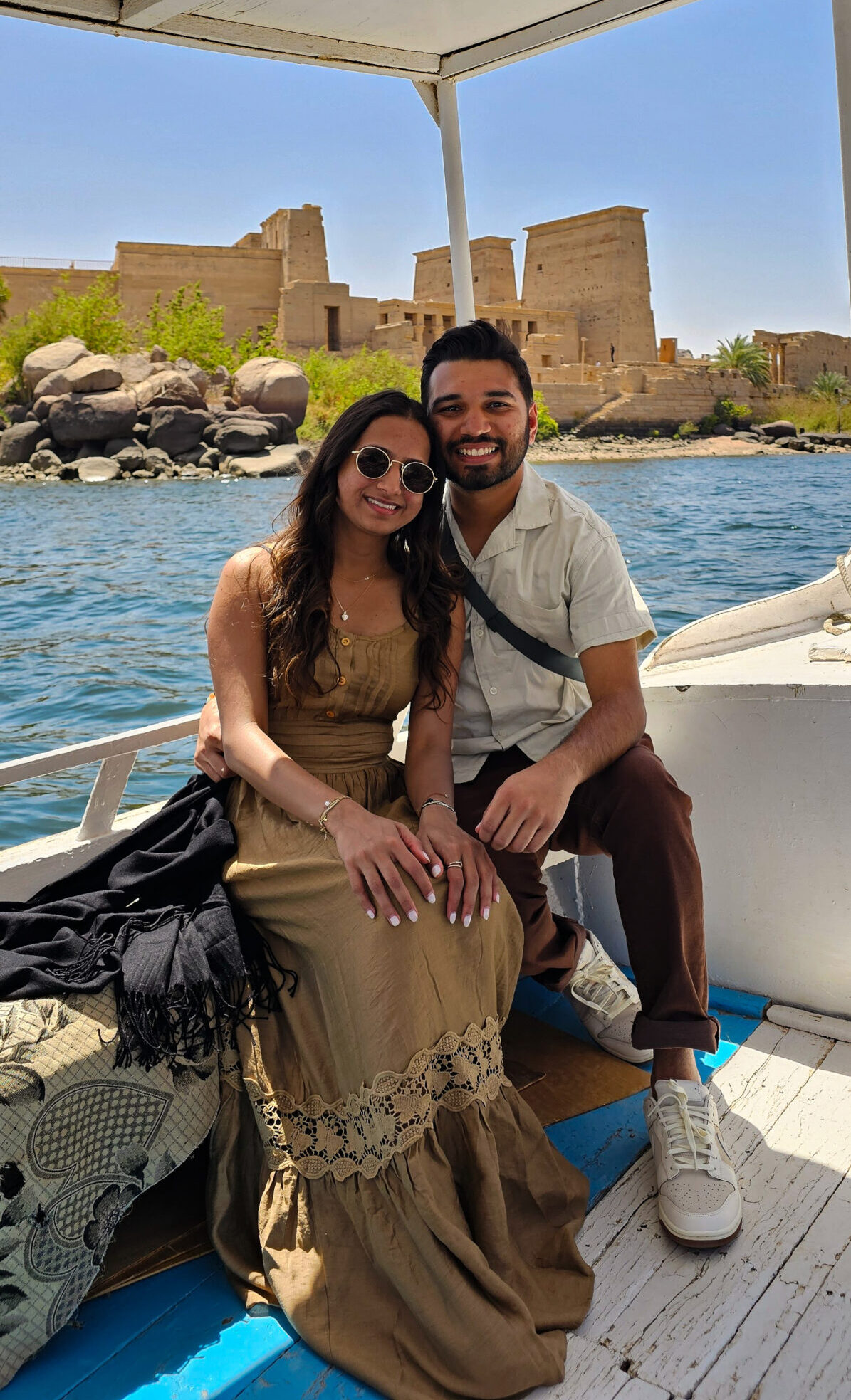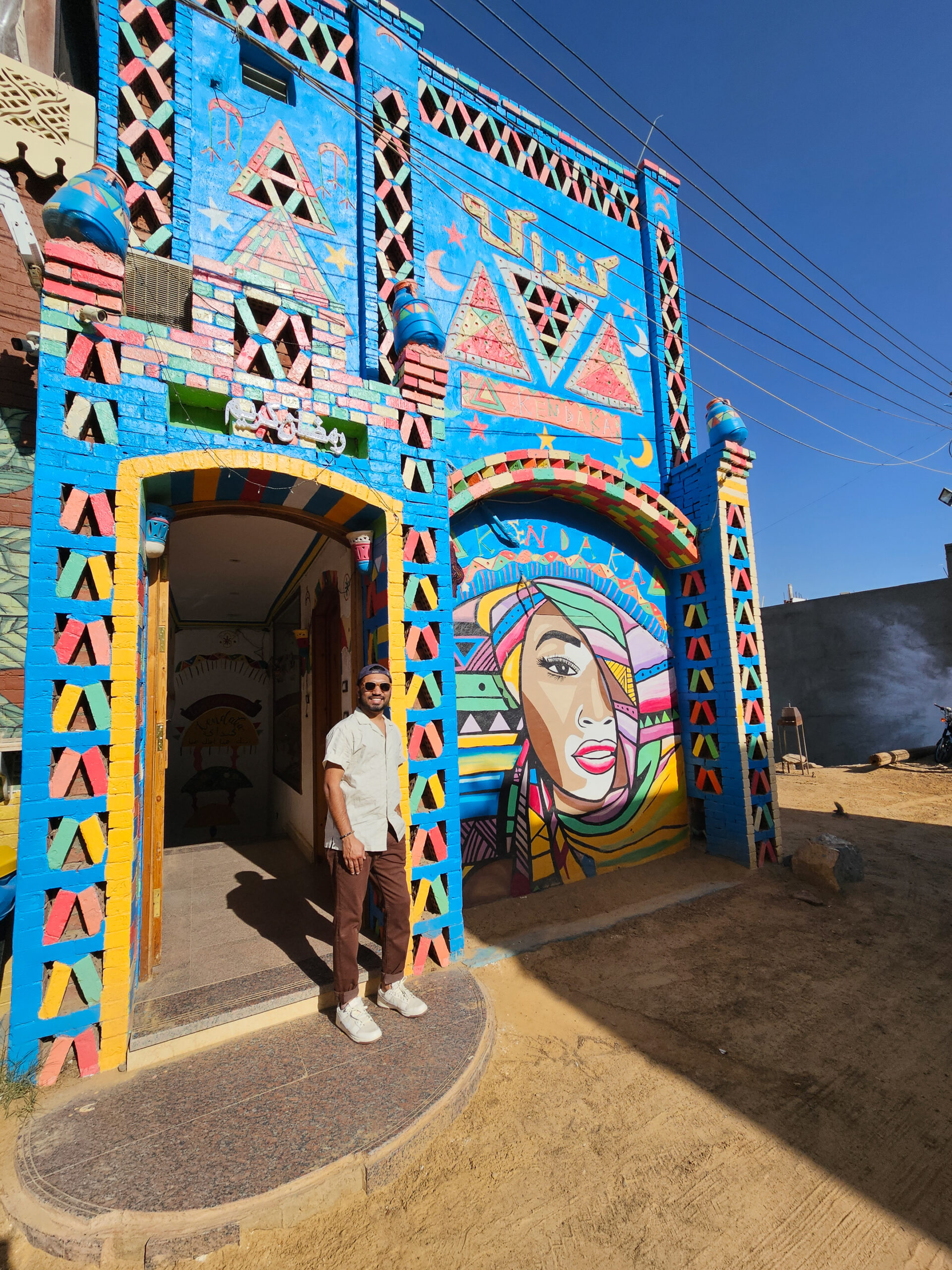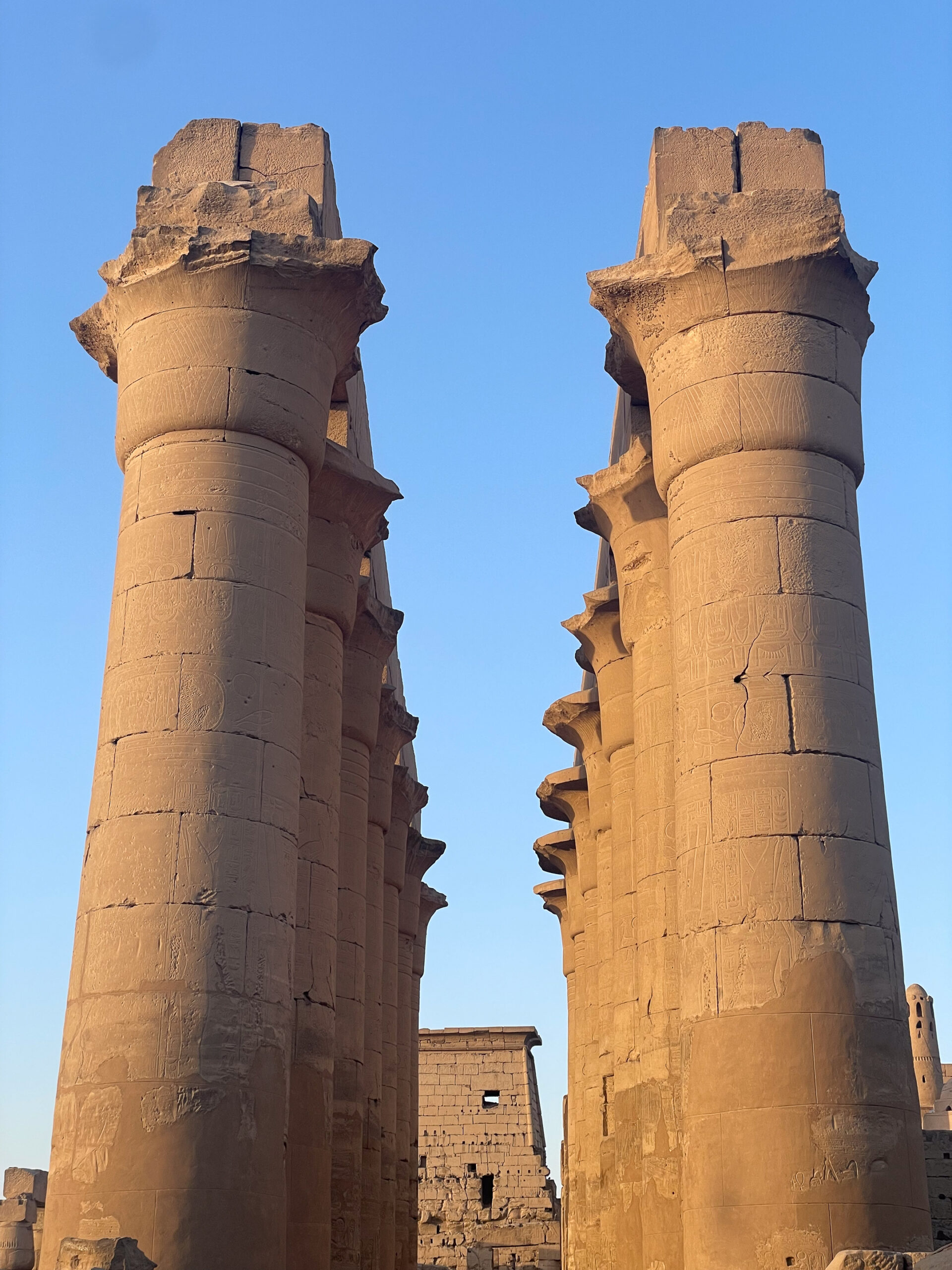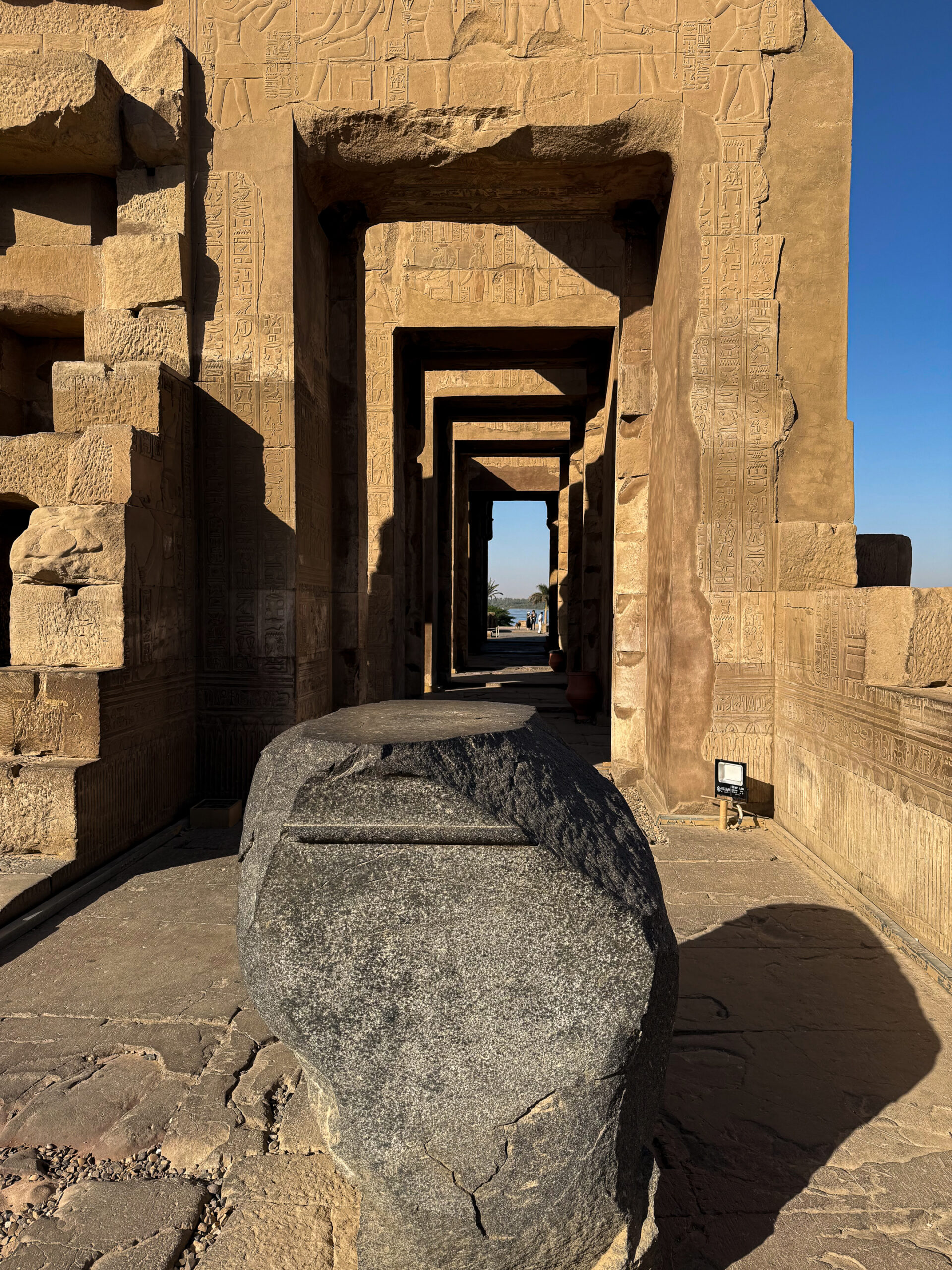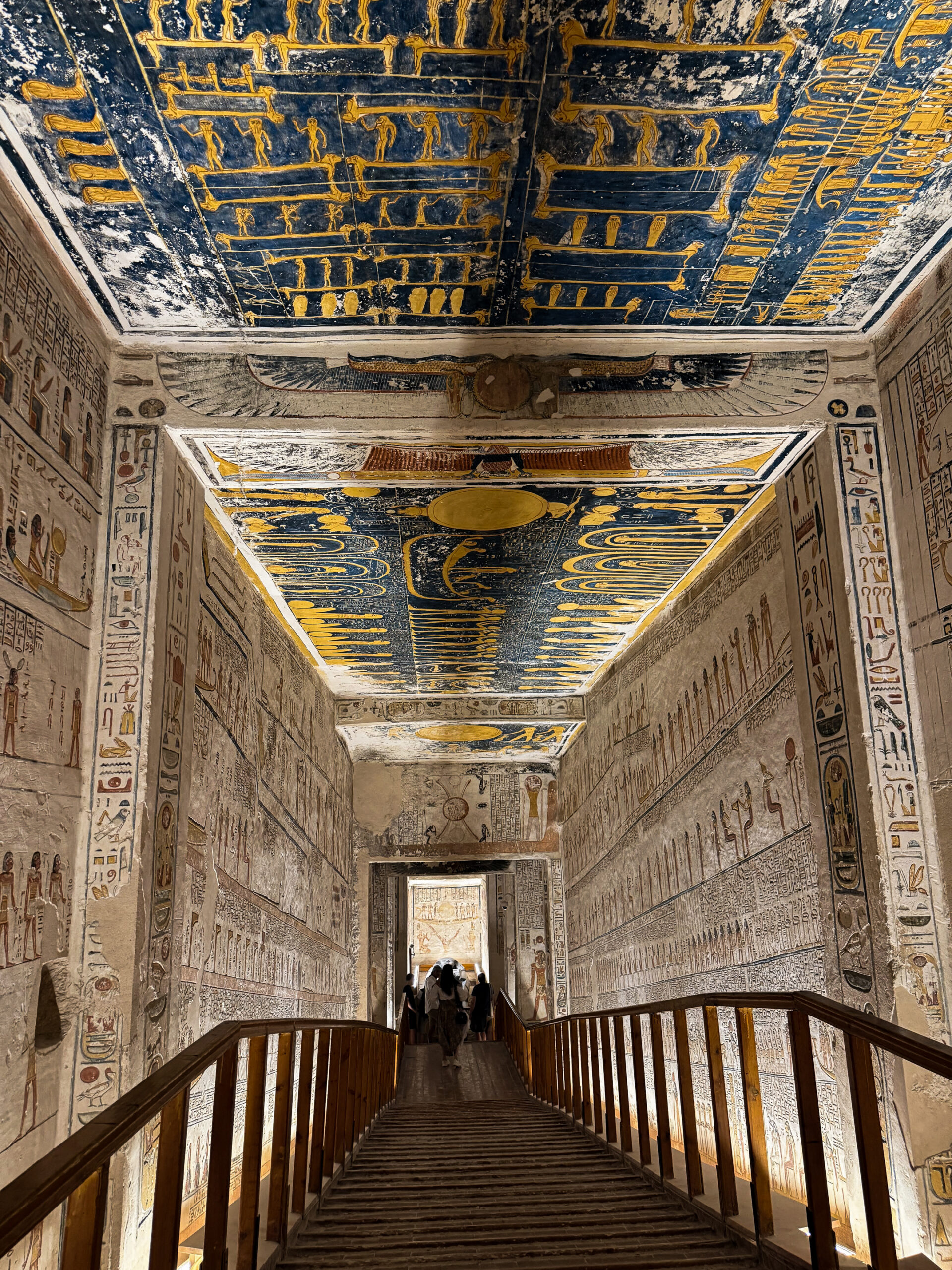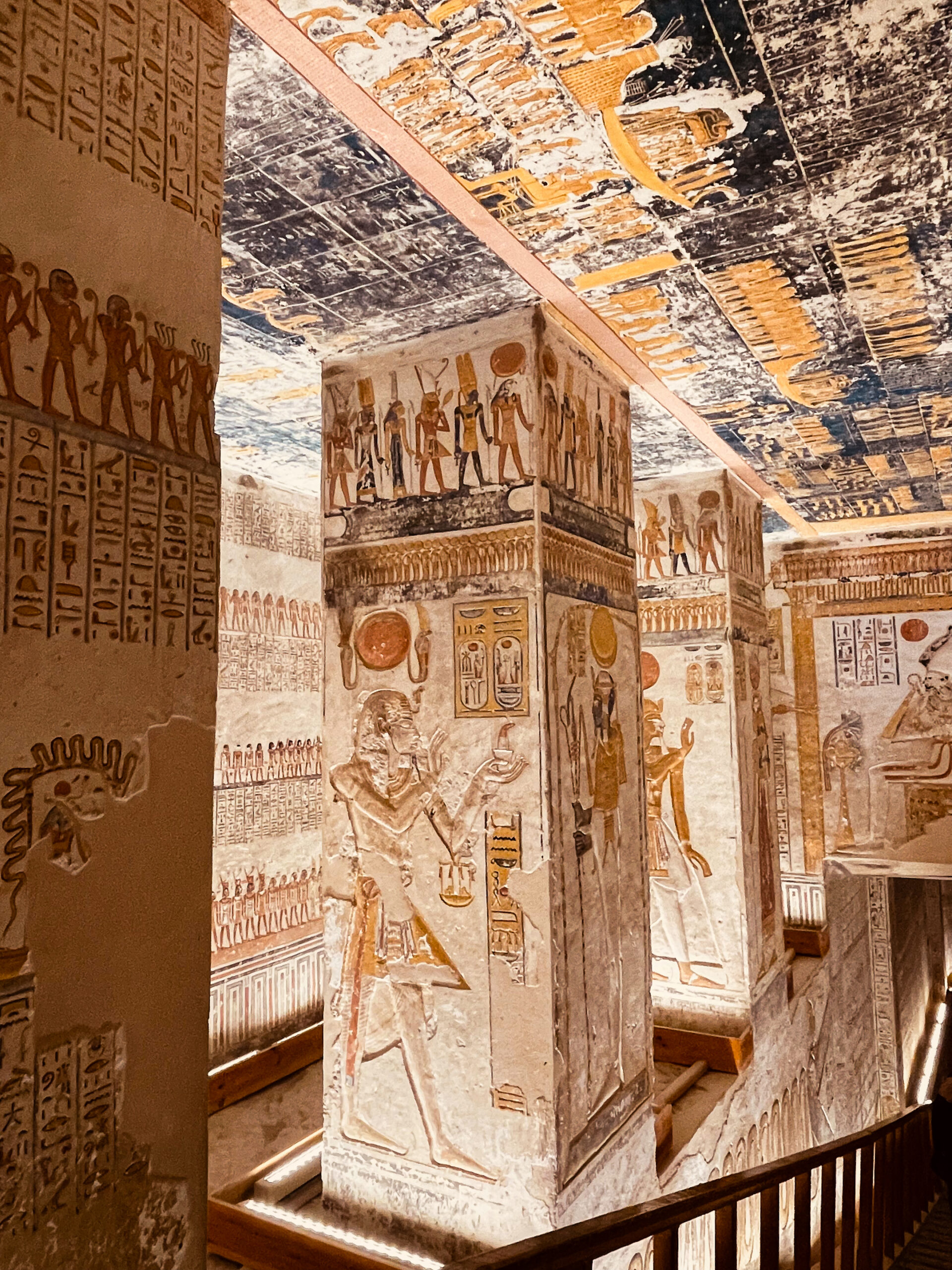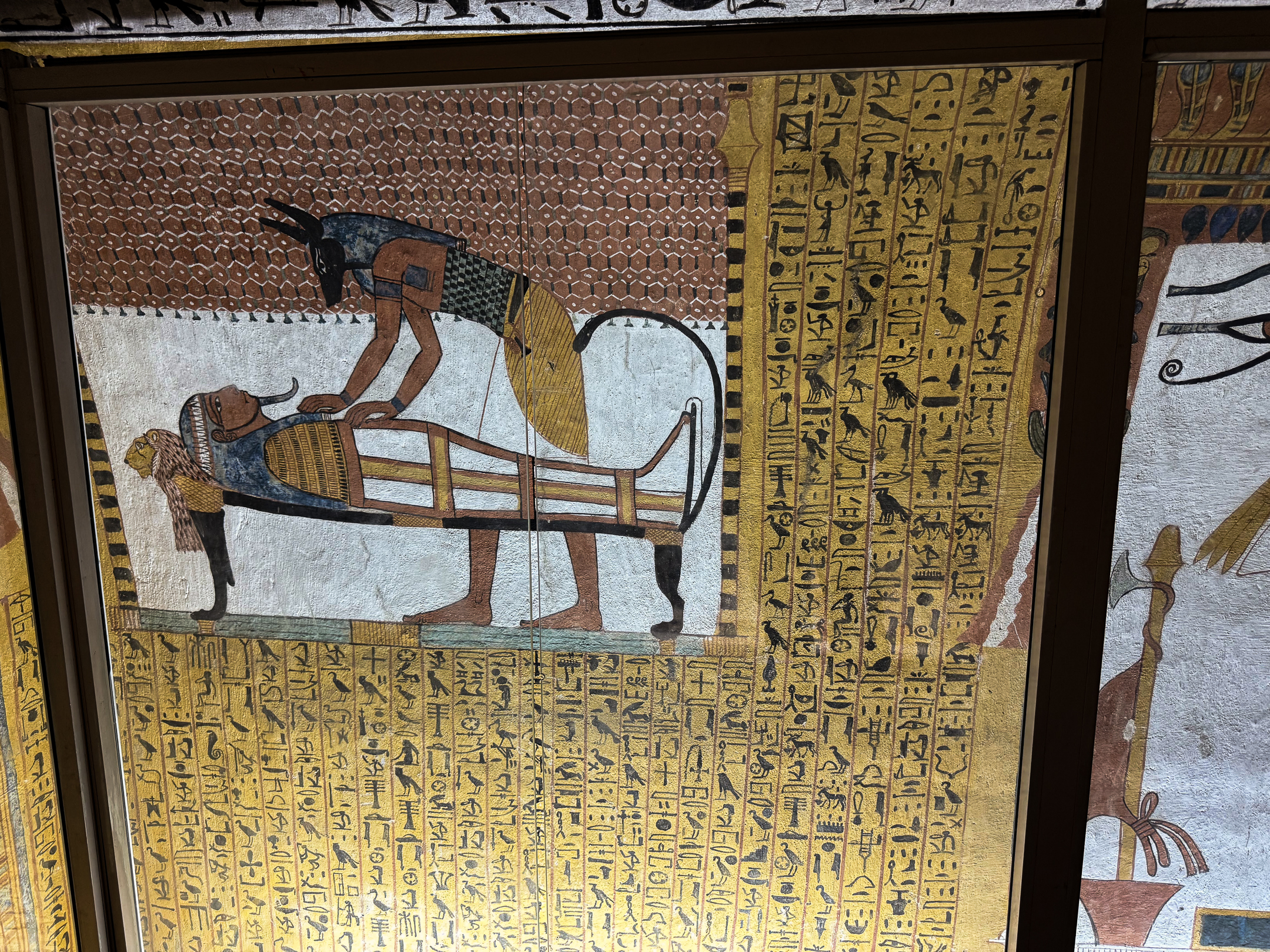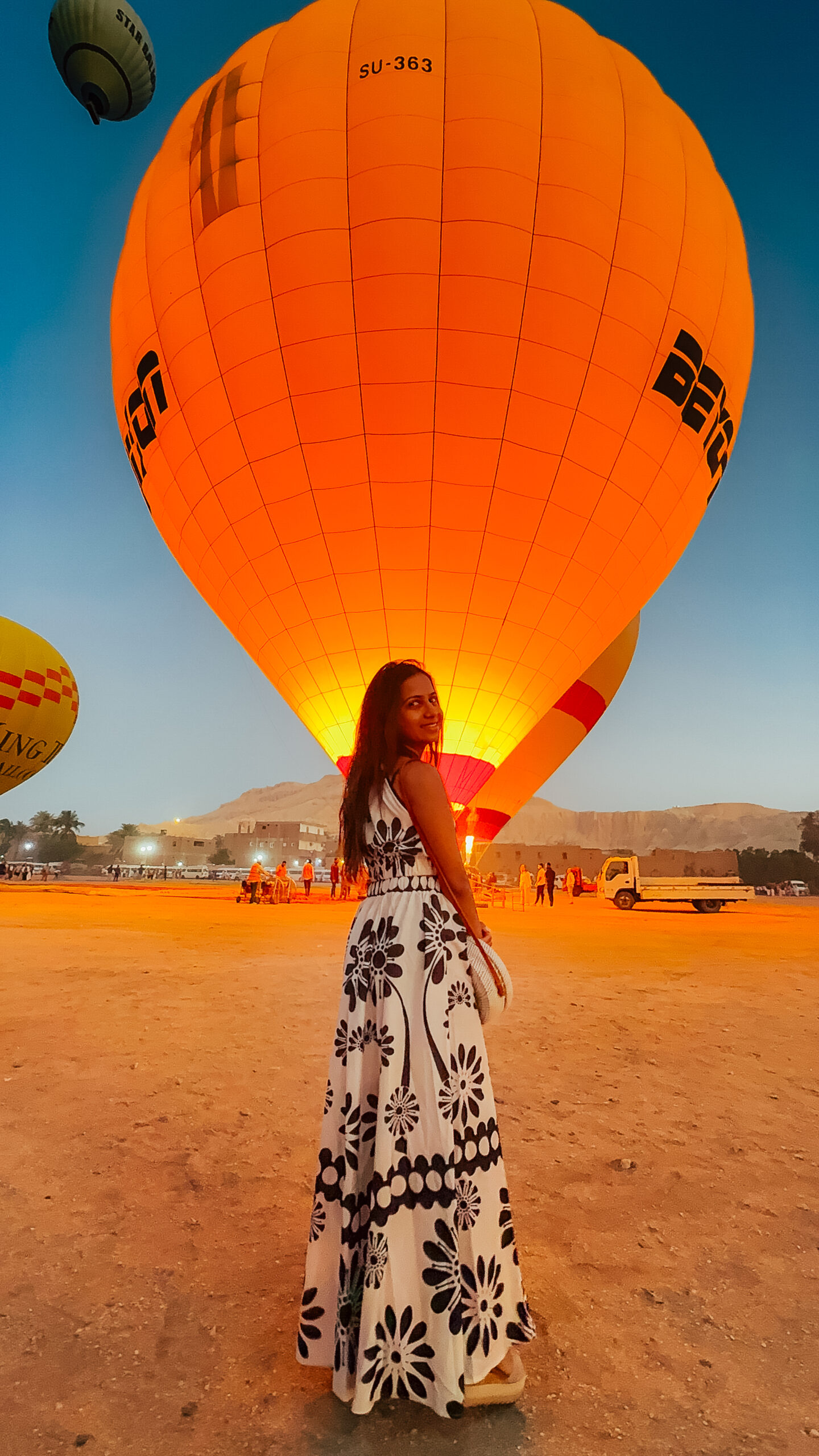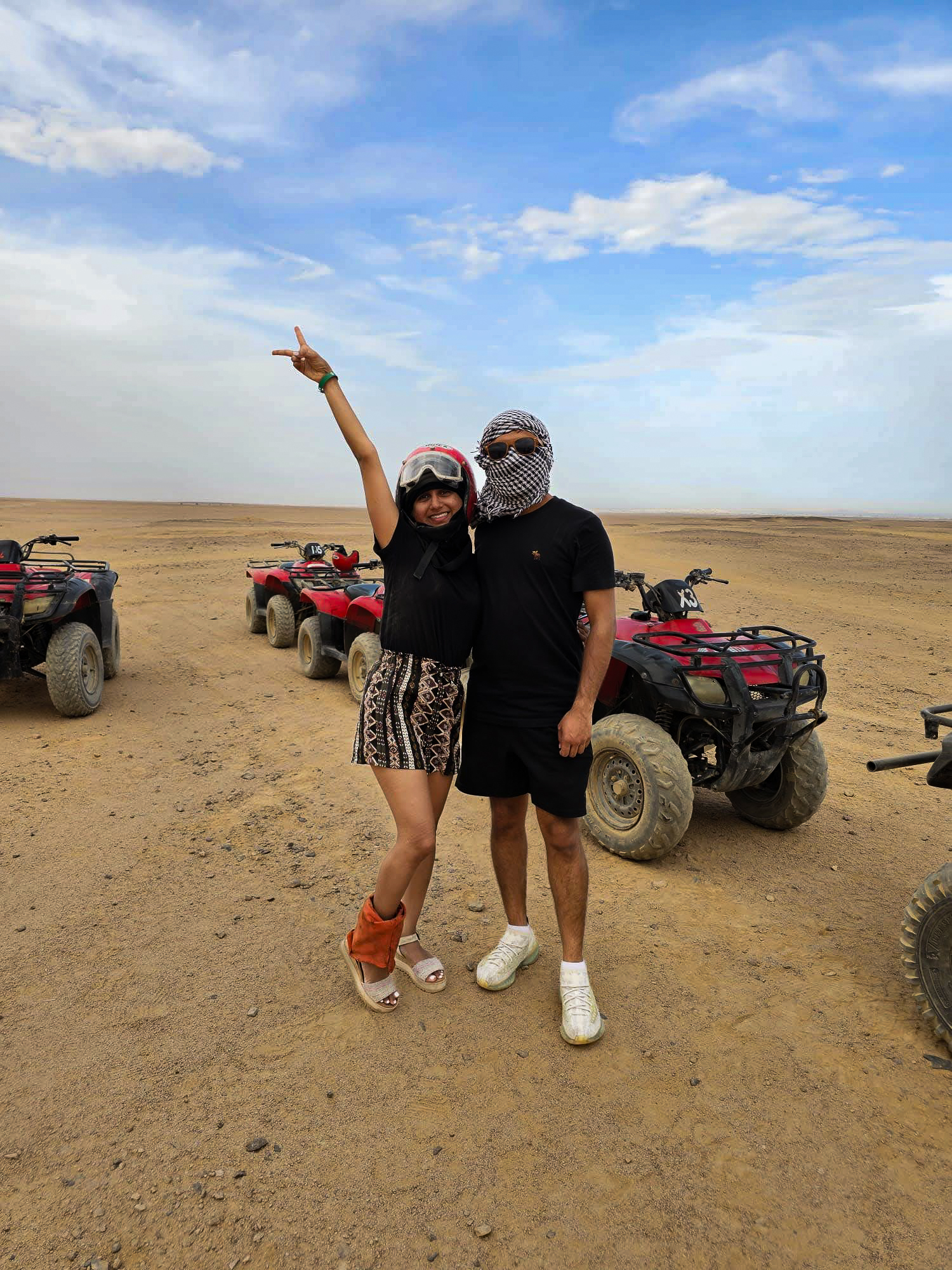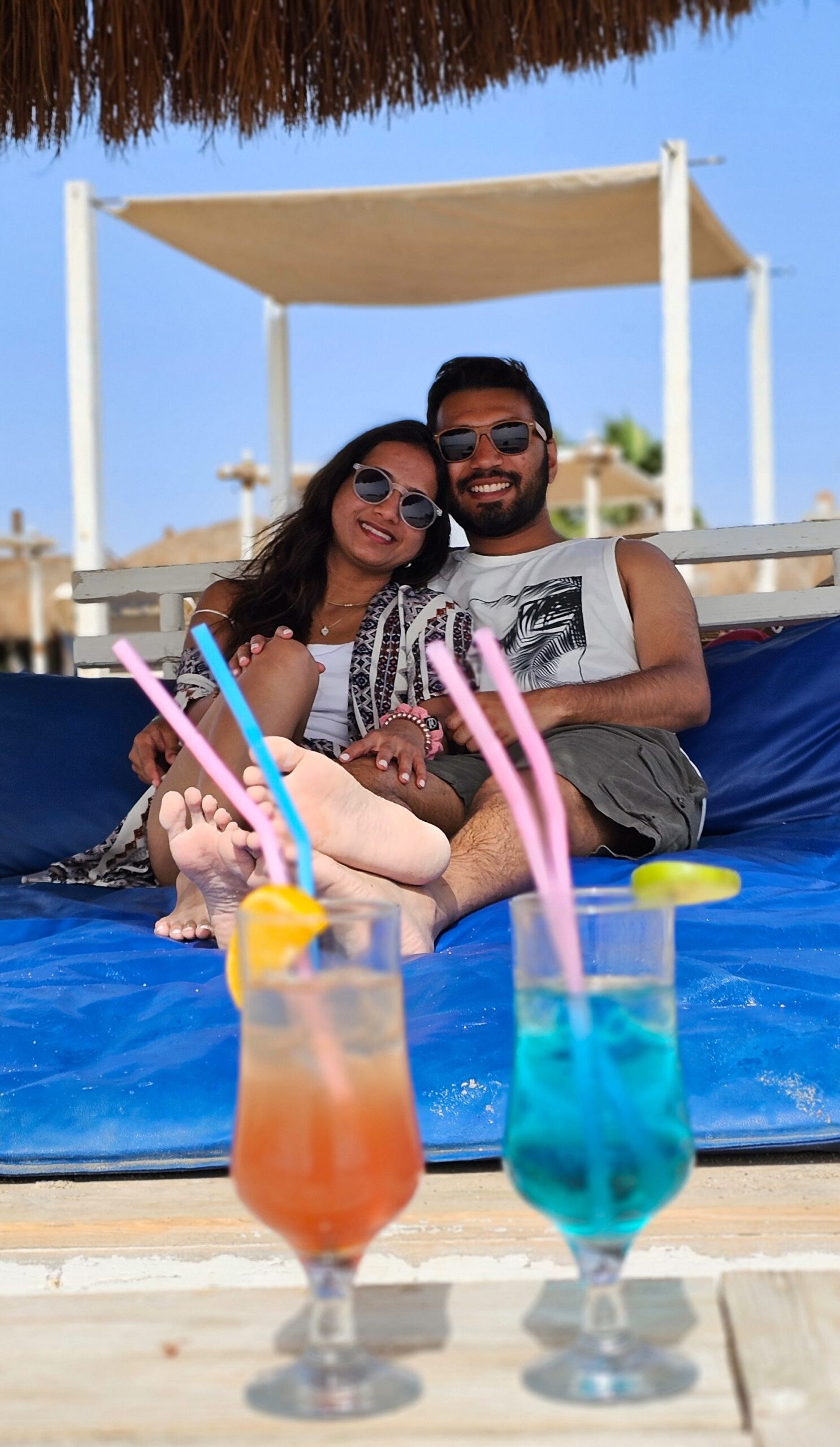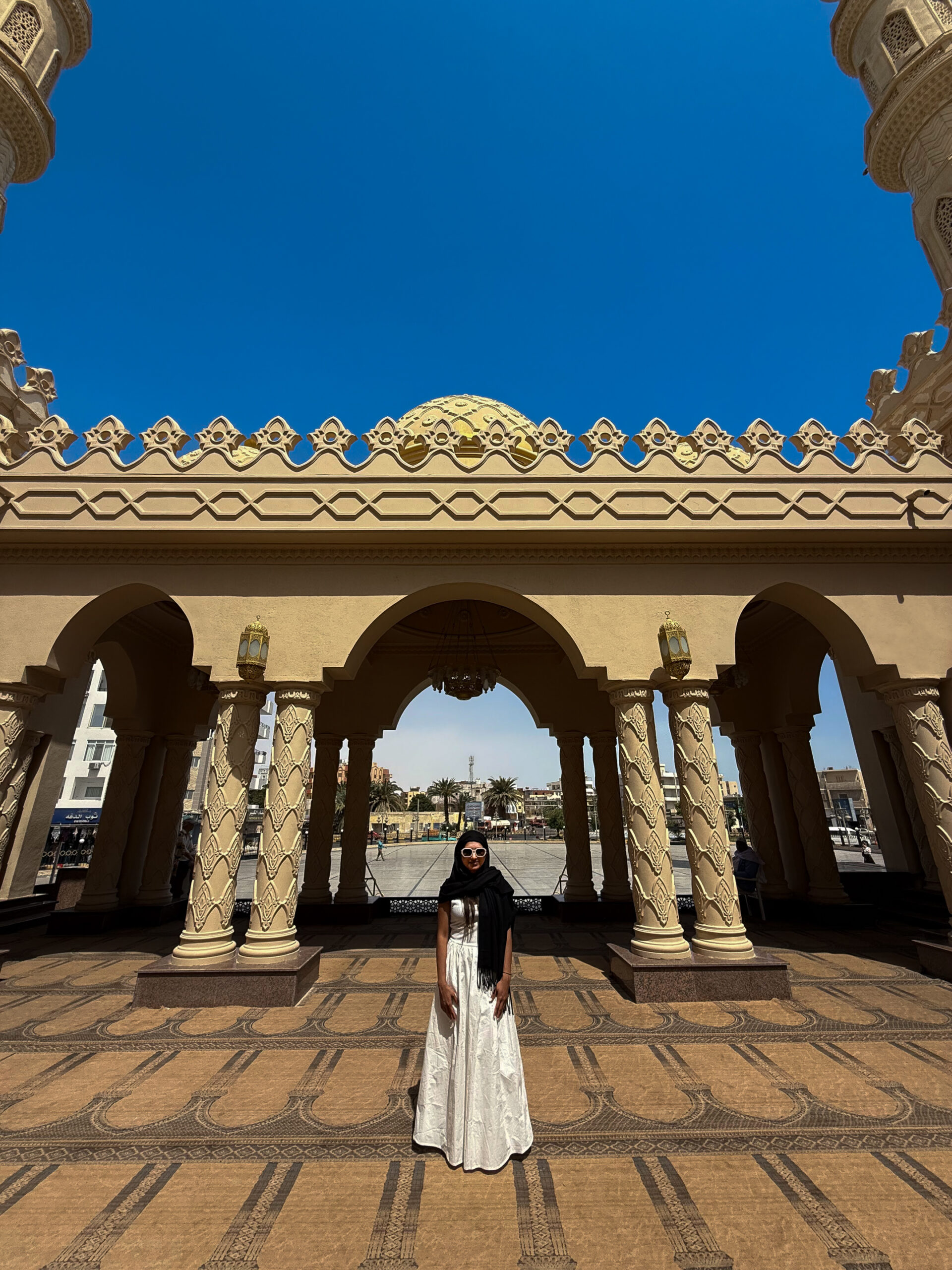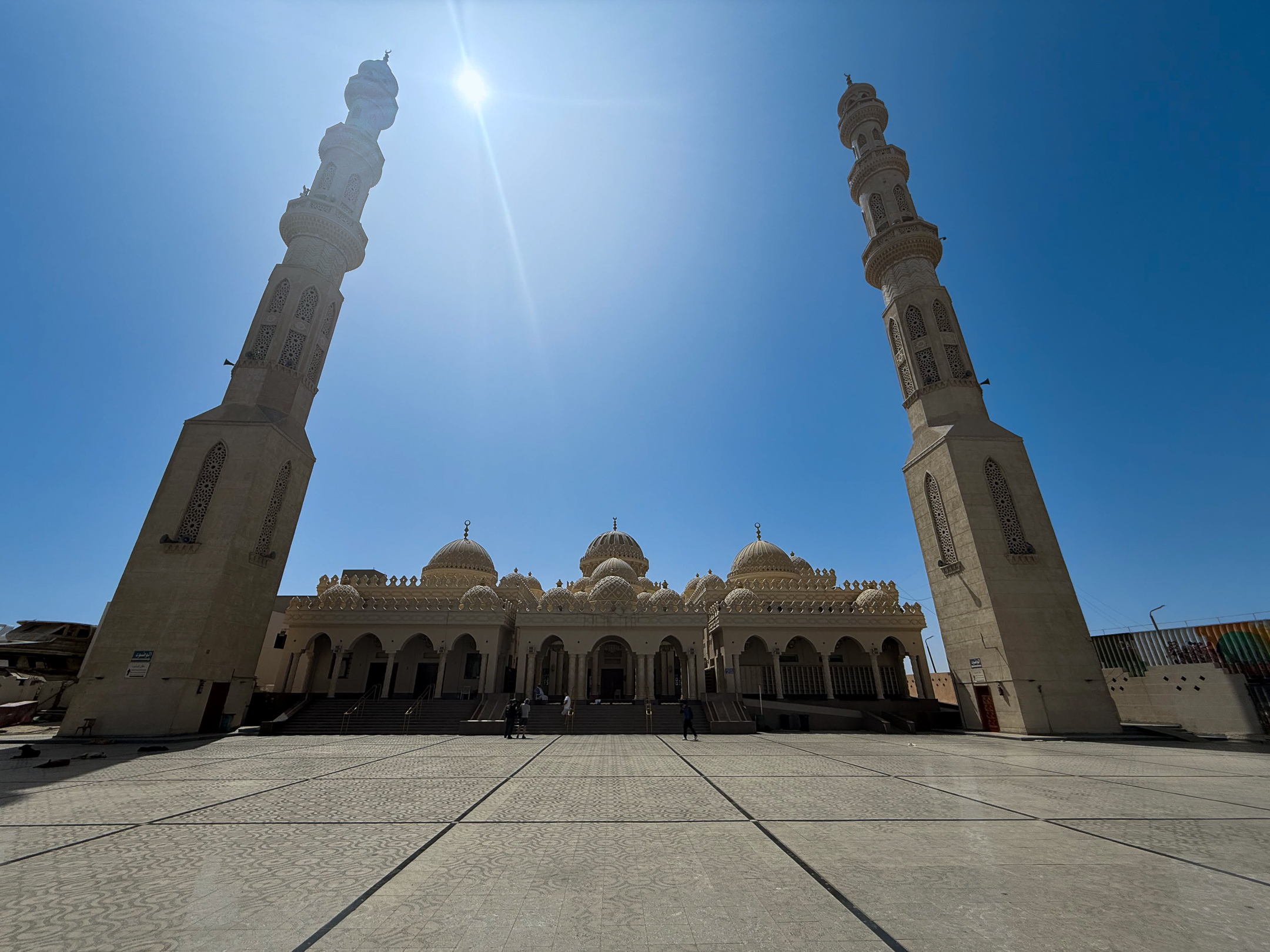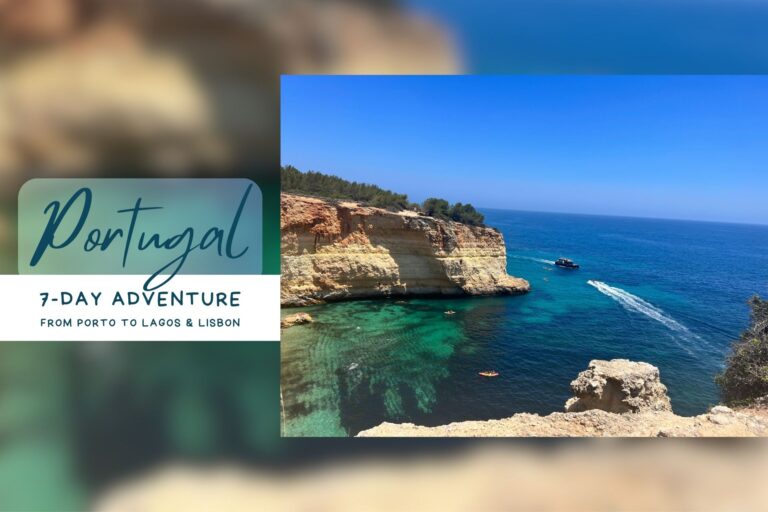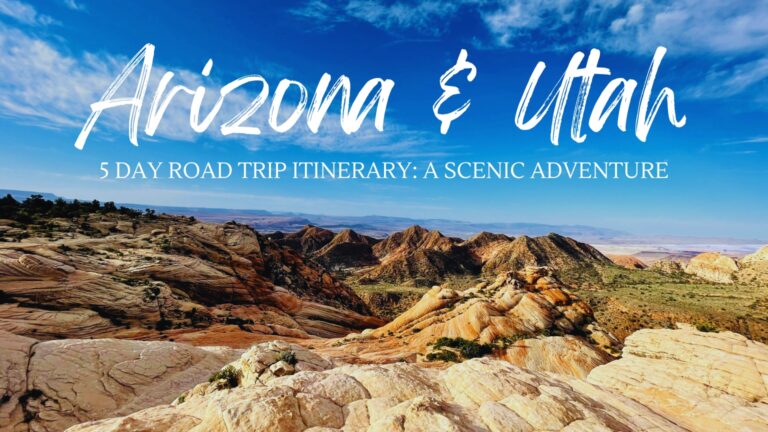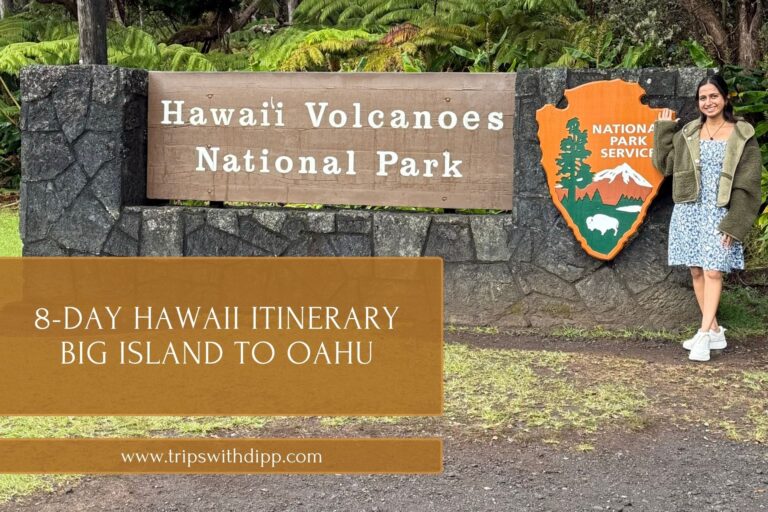10 Days Egypt Itinerary: Ancient Wonders & Local Treasures
If you’re dreaming of ancient wonders, golden deserts, and vibrant culture, this 10-day Egypt itinerary is perfect! It covers iconic spots like the Pyramids of Giza, the Sphinx, Luxor’s Valley of the Kings, and a scenic Nile River cruise. Plus, I’ll share local tips and hidden gems that made our trip unforgettable!
Day 1 – Travel Day
This was our travel day. The excitement was building. Egypt had always fascinated us – mummies, pyramids, the Nile and we were finally going.
Day 2 – Arrival in Cairo, Egyptian Museum & Khan El-Khalili
We arrived in Cairo early in the morning. After going through immigration and collecting our luggage, we headed straight to our hotel, located just steps away from the Giza Plateau. The highlight of this hotel was definitely the rooftop, which offered stunning views of the pyramids especially beautiful during sunset.
After a quick rest and freshening up, we booked an Uber (which we used throughout our time in Cairo. It was much safer and easier than local taxis) and made our way to the Egyptian Museum in Tahrir Square. This museum is a must-visit for anyone interested in ancient history. It holds over 120,000 artifacts, including some of the most iconic treasures from Ancient Egypt.
Some of the highlights were the golden mask of Tutankhamun, ancient jewelry, massive statues, scrolls made of papyrus and the Royal Mummies Hall, where the preserved remains of pharaohs are on display. You can easily spend a couple of hours exploring the museum. It can get quite warm inside, so it’s a good idea to bring water and maybe a portable fan.
In the evening, we went to Khan El-Khalili Bazaar, one of the oldest and liveliest markets in the Middle East. It’s been around since the 14th century and is full of narrow alleys and colorful shops selling everything from spices and lanterns to perfumes, jewelry, and souvenirs. The atmosphere is lively with so much to see and experience.
For dinner, we ate at the famous Naguib Mahfouz Café, right in the heart of the market. The café is named after Egypt’s Nobel Prize-winning author and is known for its traditional Egyptian food and elegant setting. We tried Koshari, one of Egypt’s most popular street foods. It’s a flavorful mix of macaroni, rice, lentils, chickpeas, and crispy onions, all topped with a tangy tomato sauce and garlic vinegar. Super delicious and very filling!
💡 Travel Tip: Bargaining is common in the bazaar, so don’t be afraid to haggle a bit. But if you prefer fixed prices, visit Jordi, a great store for souvenirs. Also, make sure to carry cash since many shops don’t accept cards.
Day 3 – Giza Pyramids, Sphinx, Saqqara & Memphis
We started our day early with a local guide, ready to explore some of the most iconic and ancient sites in Egypt. Our first stop was the Giza Plateau, home to the Great Pyramids of Giza, one of the most famous landmarks in the world. These pyramids were built more than 4,500 years ago as tombs for the pharaohs and remain the only surviving wonder of the original Seven Wonders of the Ancient World. Standing in front of them felt unreal – the size, the history, and the precision of their construction leave you absolutely speechless.
Right next to the pyramids is the majestic Great Sphinx of Giza, a massive limestone statue with the body of a lion and the face of a pharaoh believed to represent King Khafre. It was built to guard the pyramids and is a powerful symbol of ancient Egyptian strength and wisdom.
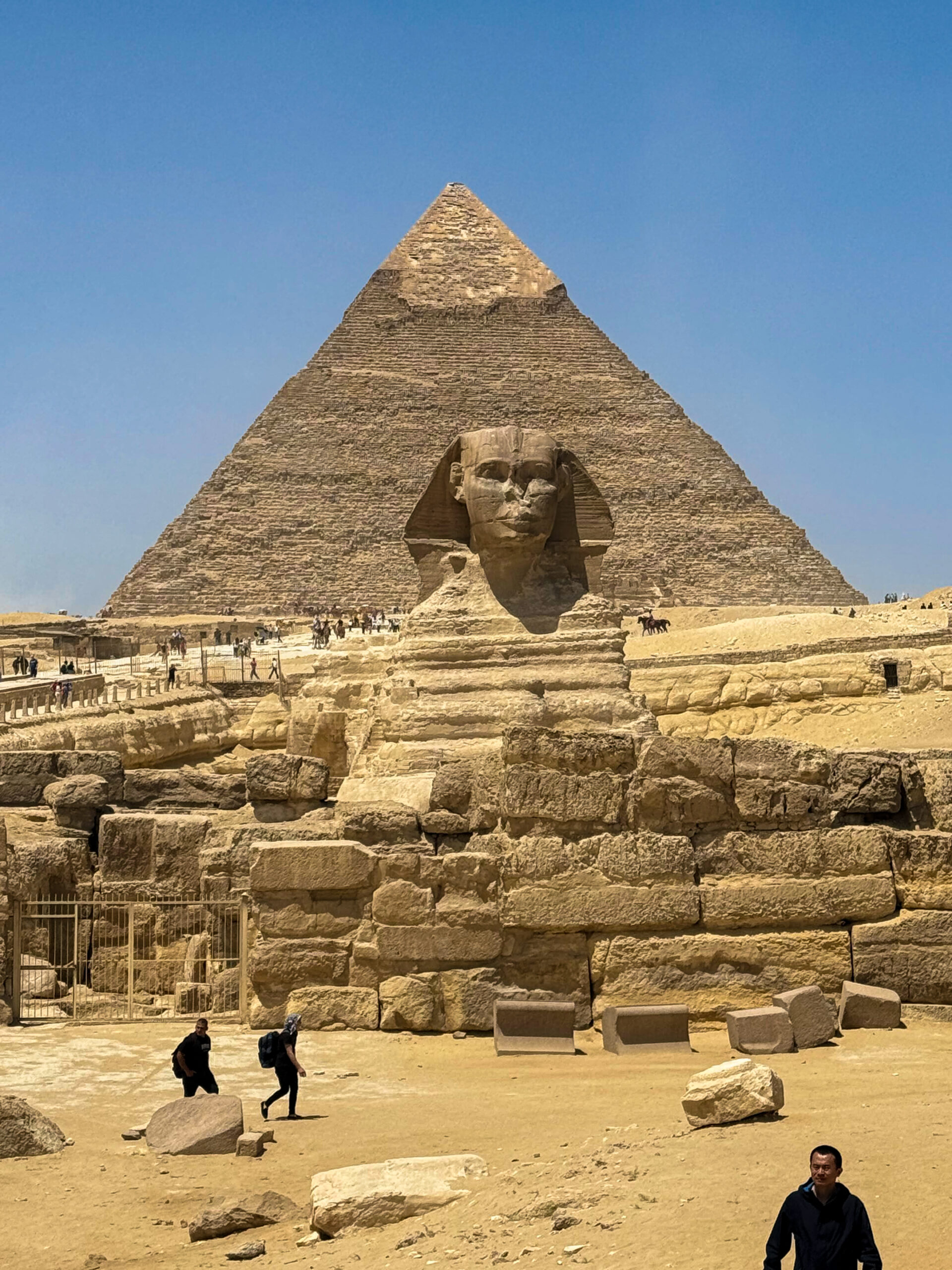 Sphinx
Sphinx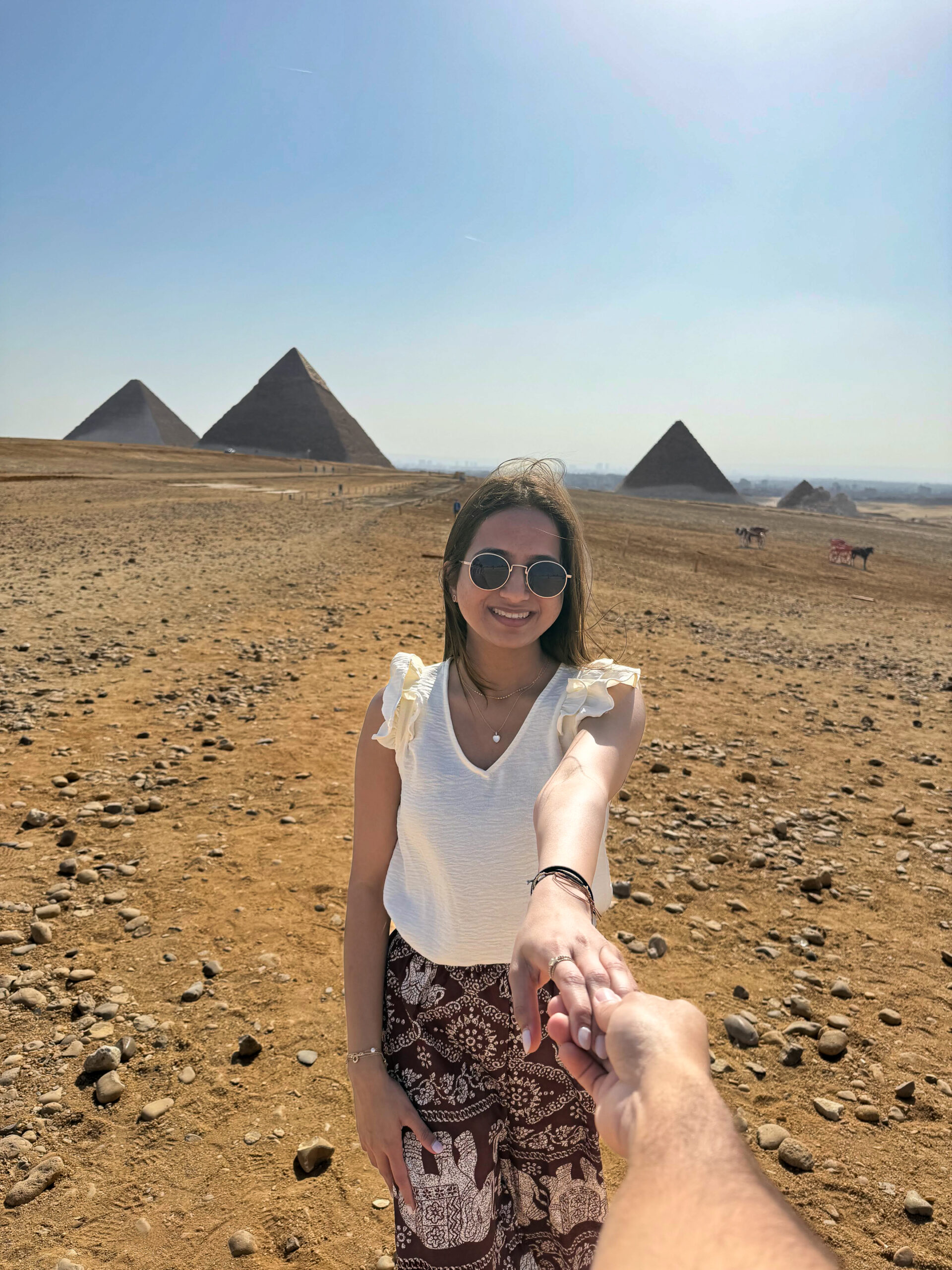 Giza Pyramids
Giza Pyramids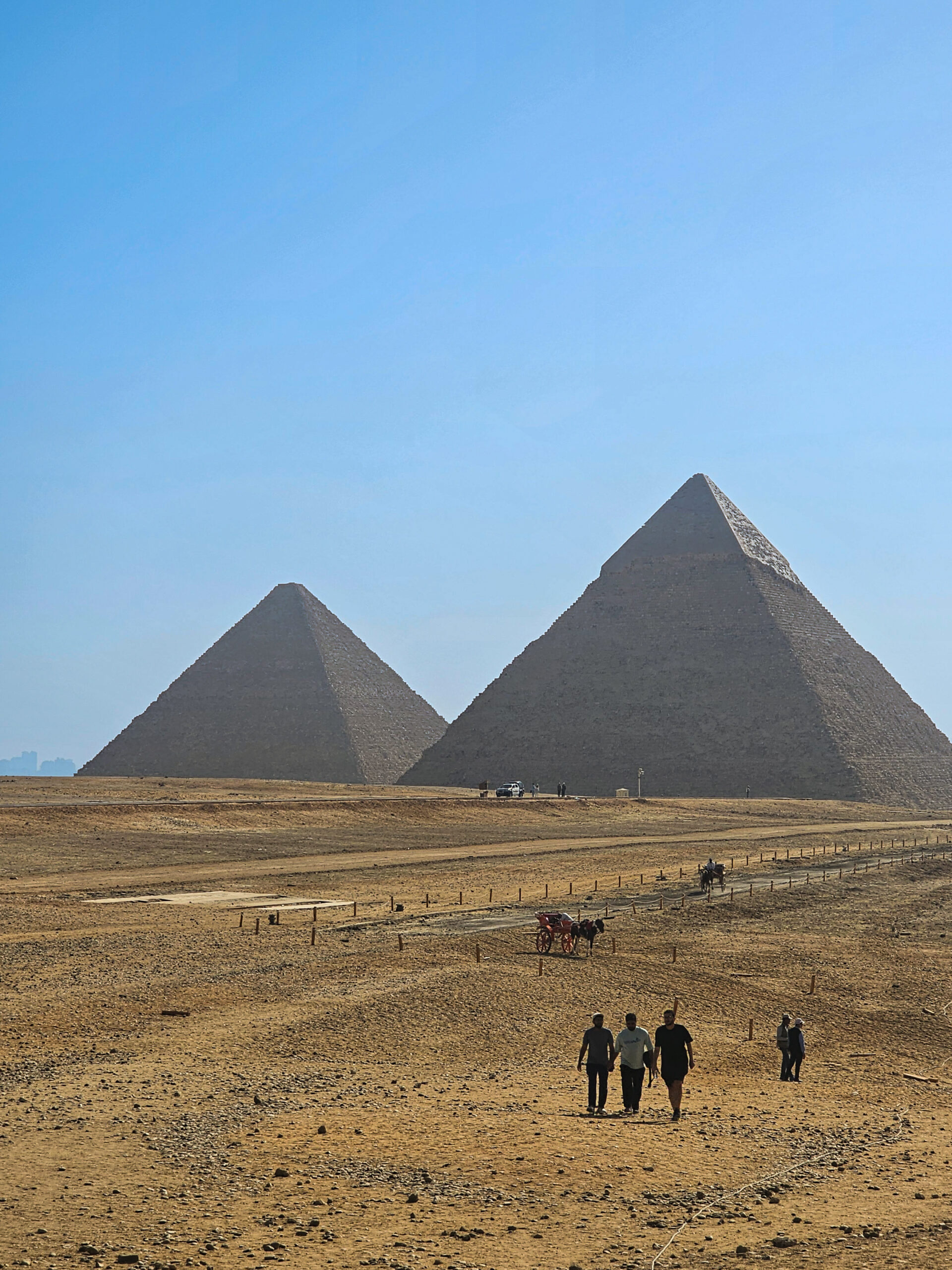 Giza Pyramids
Giza Pyramids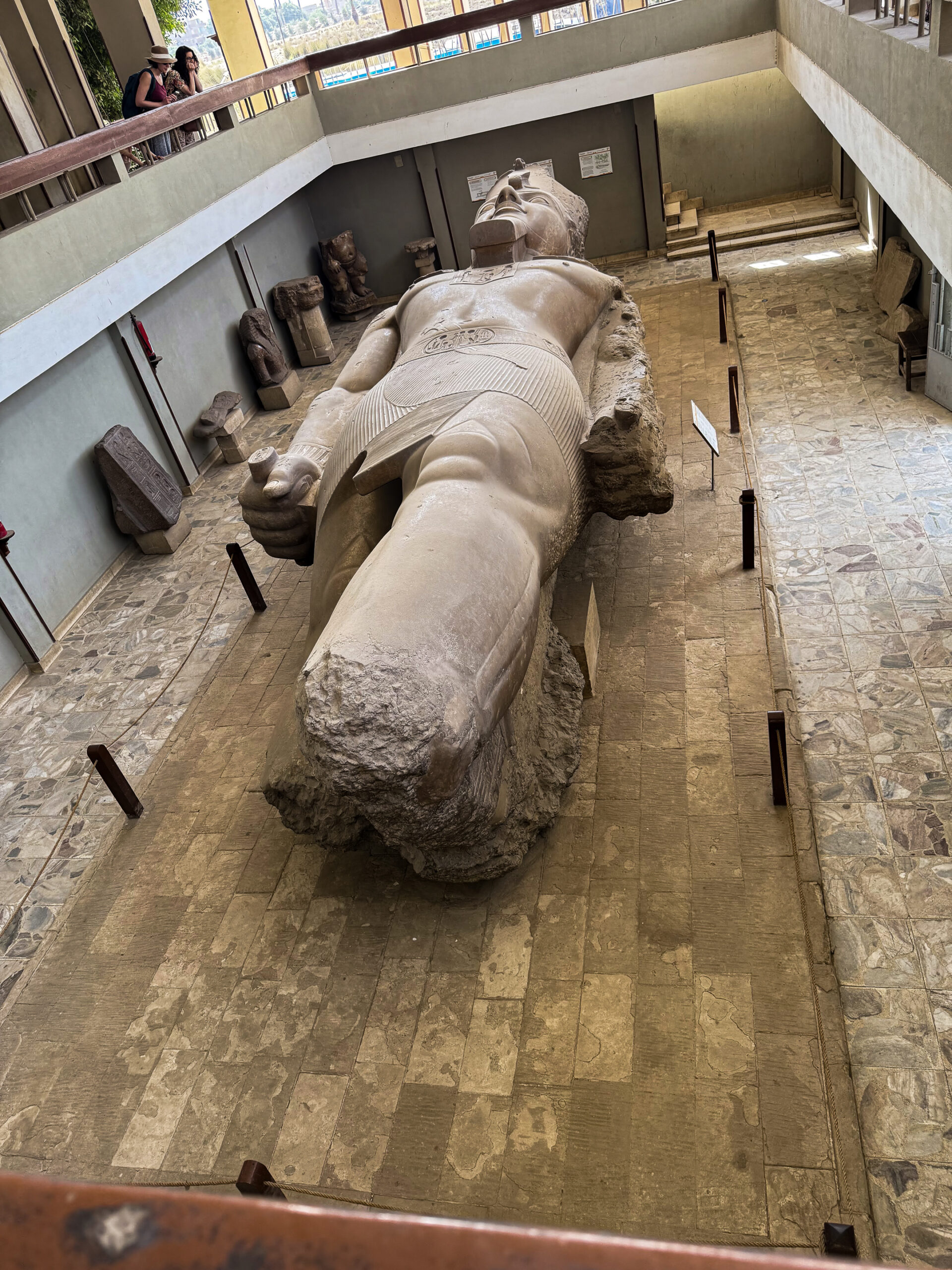 Ramses the Great
Ramses the Great
After soaking in the views at Giza, we continued our journey to Saqqara, one of the oldest and most important archaeological sites in Egypt. This is where you’ll find the Step Pyramid of Djoser, built in the 27th century BC and considered the world’s very first pyramid. Unlike the smooth-sided pyramids at Giza, this one has a stepped design, showing how pyramid architecture evolved over time.
Saqqara is more than just pyramids, it’s full of hidden tombs, many of which are open to visitors. We explored some of these tombs and were amazed by the incredibly well-preserved hieroglyphics and colorful wall carvings showing scenes from everyday life, offerings to gods, and ancient rituals. It felt like stepping back in time.
Our final stop for the day was Memphis, the first capital of ancient Egypt, located just a short drive from Saqqara. Today, it’s an open-air museum filled with fascinating statues and ruins. The most impressive piece here is the massive fallen statue of Ramses II, lying on its back in a covered pavilion. You can really see the scale of how grand pharaohs wanted their images to be. There’s also a beautiful alabaster sphinx, smaller than the one at Giza but still incredibly detailed.
This day was packed with history and gave us a deeper understanding of how ancient Egypt developed from the earliest pyramids to powerful pharaohs who ruled from Memphis. Every site we visited added a new layer to the story.
💡 Travel Tip: Start early to beat the heat and the crowds. Comfortable walking shoes, sunblock, water, and a hat are a must for a full day exploring under the Egyptian sun.
Day 4 – Flight to Aswan, Philae Temple & Nubian Village
We had an early start with a 6 AM flight to Aswan, a peaceful city in southern Egypt known for its beautiful Nile views and relaxed pace. After arriving, we checked into our Airbnb – Nile View Apartment. The place had a stunning view of the river, making it the perfect spot to unwind after a travel day.
That morning, we also met our private driver, whom we had booked for the rest of our trip through Upper Egypt. Having a dedicated driver made exploring much easier and more comfortable, especially when visiting places a bit off the main tourist path.
Our first stop was the magical Philae Temple, dedicated to the goddess Isis. We took a short boat ride to Agilkia Island, where the temple now sits. It was originally located on Philae Island but had to be moved block by block to protect it from flooding after the construction of the Aswan High Dam. The temple is beautifully surrounded by water, and its peaceful setting makes the experience even more special.
Inside, we explored tall stone columns, detailed carvings, and ancient hieroglyphics. It’s also known as the last temple where hieroglyphs were ever written, marking the end of an era in ancient Egyptian history.
In the afternoon, we took a relaxing boat ride to the Nubian Village, one of the most colorful and culturally rich places we visited in Egypt. As we arrived, we noticed the brightly painted houses and the warm, welcoming atmosphere. The people here were incredibly friendly and happy to share their traditions with visitors.
We saw a large crocodile and a smaller crocodile in a local Nubian home. In Nubian culture, crocodiles are considered very sacred and bring good luck. They’re often kept as symbols of protection and strength, and it was fascinating to hear the stories behind this tradition.
Our hosts at the Nubian house offered us traditional tea and welcomed us like family. We explored the village, saw small shops selling local handicrafts, like handmade jewelry, spices, and textiles. For lunch, we enjoyed a delicious homemade Nubian meal – fresh, flavorful, and cooked with so much love. The food was simple yet full of flavor, with traditional dishes you won’t find in tourist restaurants.We ended the day with a beautiful sunset by the Nile. It was the perfect, peaceful way to close out an incredible day in Aswan.
💡 Travel Tip: The boat ride to the Nubian Village is worth it for the views alone. Visiting the Nubian Village is a great way to support local communities and learn about a culture that’s very different from mainstream Egypt. Don’t forget to bring small cash for souvenirs, and consider tipping your boat driver or local host.
Day 5 – Abu Simbel
We started our day very early before sunrise for a road trip from Aswan to Abu Simbel, one of the most famous temples in all of Egypt. The drive took about 3 hours each way through the desert, and our private driver handled everything, including a travel permit which is required for this route.
Abu Simbel is home to two massive rock-cut temples built by Pharaoh Ramses II in the 13th century BC. The temples were carved into the mountainside to show the power and glory of the pharaoh. In the 1960s, both temples were moved to higher ground, block by block, to save them from being flooded after the Aswan High Dam was built. This was one of the biggest archaeological rescue projects in the world.
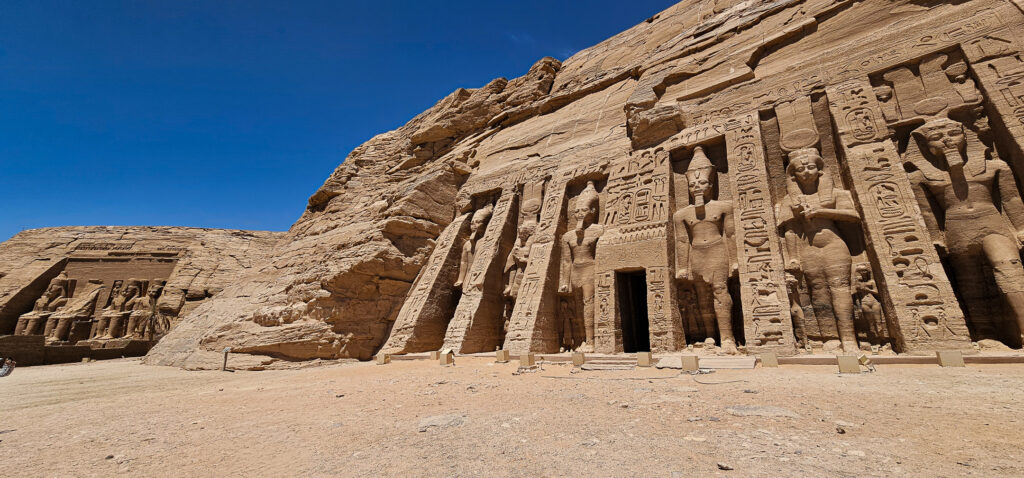
The main temple is dedicated to Ramses II himself. At the entrance, you’ll see four giant statues of the pharaoh, each over 20 meters tall. Inside, the temple has huge stone columns, detailed wall carvings, and statues of gods and Ramses in battle scenes. At the back of the temple, in the inner sanctuary, there are four seated statues. Twice a year, on February 22 and October 22, sunlight shines through the entrance and lights up these statues, a perfect example of ancient Egyptian science and architecture.
Next to it is the smaller temple, dedicated to Queen Nefertari, Ramses’ wife. The front of this temple also has six statues, four of Ramses and two of Nefertari. Inside, there are beautiful carvings of Nefertari giving offerings to the gods. It’s one of the few temples where a queen is shown as equal to the king, which makes it even more special.
Both temples are incredibly beautiful and full of history. Seeing them up close is a once in a lifetime experience. The statues are huge, the carvings are detailed, and the location near Lake Nasser makes it even more peaceful.It was very hot, even in the morning, so make sure to carry water, sunscreen, a hat, and sunglasses. There are basic restrooms and a small café at the site, but not much shade, so come prepared.
💡 Travel Tip: If you’re traveling between cities in southern Egypt, like Aswan to Abu Simbel, or Aswan to Luxor, you will need a permit to pass through the desert. Your driver or tour guide will arrange it in advance. Also, keep in mind that private cars are not allowed to go after 6 PM due to security rules. This is why most trips to Abu Simbel leave very early in the morning and return before evening.
Day 6 – Luxor East Bank (Karnak & Luxor Temples)
We left Aswan in the morning and drove to Luxor, a city filled with history and often called the world’s greatest open-air museum. The drive took about 4 hours, passing through peaceful desert landscapes.
Once we arrived, we checked into our Airbnb, located on the West Bank of Luxor. The home was cozy, surrounded by greenery, and hosted by a kind local family. After getting freshened up, we headed out to explore the East Bank of Luxor.
Our first stop was the stunning Karnak Temple, one of the largest and most impressive temple complexes in all of Egypt. Built over more than 2,000 years by different pharaohs, it was the main religious center of ancient Thebes. The site is massive, you can walk through different temple sections, pylons, and chapels. The most famous part is the Great Hypostyle Hall, with 134 giant stone columns that seem to stretch endlessly toward the sky. It’s truly breathtaking. We also walked around the Sacred Lake, once used for religious rituals, and stopped at the scarab beetle statue where we walked around it counter-clockwise for good luck, just as ancient Egyptians believed.
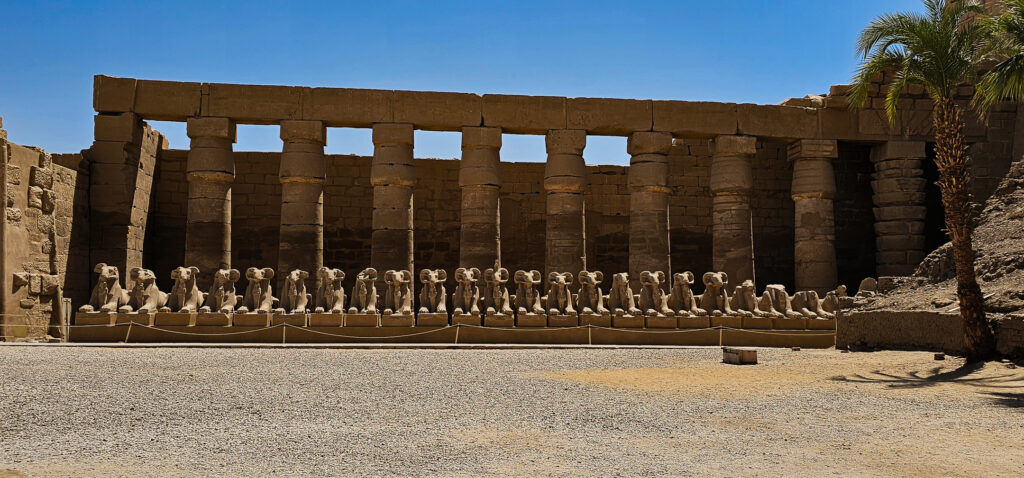
After exploring Karnak for about 3 hours, we headed to Paris Restaurant for lunch. It’s a well-known local spot, and their food did not disappoint. We had tagin, a slow-cooked Egyptian dish served in a clay pot. It was packed with flavor and probably one of the best local meals we had on the trip.
In the late afternoon, our driver took us to a charming local place called Om Kulthum Café. It was a small, laid-back café with a cozy vibe, and they served the freshest mango and guava juice perfect for cooling down after a hot afternoon.
As the weather cooled down, we visited Luxor Temple, located right in the heart of the city. Unlike Karnak, which was used for religious ceremonies, Luxor Temple was more about celebrating kingship and royal power. It was originally built by Pharaoh Amenhotep III and later expanded by Ramses II, with contributions from other rulers like Alexander the Great. One of the unique things about Luxor Temple is that it blends multiple layers of history in one place.You’ll see Egyptian carvings, Roman additions, and even an active mosque built directly into the temple walls.
We also saw the Avenue of the Sphinxes, a historic pathway lined with hundreds of human-headed lion statues. This grand avenue once connected Karnak Temple to Luxor Temple, stretching over 2.7 kilometers. It was used for important religious processions and festivals, especially during the Opet Festival, where statues of the gods were carried from Karnak to Luxor. Standing along the path today, it’s incredible to imagine the ceremonies that once took place here thousands of years ago.
Day 7 – Hot Air Balloon Over Luxor & West Bank Exploration
We woke up in the early hours of the morning before the sun even peeked over the horizon. Our day began at 4 AM with something we had been dreaming about for months: a hot air balloon ride over Luxor. Our kind Airbnb host had arranged everything for us, and the balloon company picked us up right from our doorstep.
As we floated into the sky in near silence, the sun began to rise over the Nile, casting a golden glow on the green farmlands, desert hills, and ancient temples below. From above, we saw the Valley of the Kings, Hatshepsut’s Temple, and the grand pillars of Medinet Habu. The entire experience felt like a dream peaceful, slow, and awe-inspiring. It’s one of those moments that stays with you long after the trip ends.
Once we landed safely, we returned to our Airbnb, got freshened up, had breakfast, and set off to explore Luxor’s West Bank, home to some of the most significant archaeological sites in Egypt.
Our first stop was the Valley of the Kings, and it quickly became one of our favorite places in Egypt. The valley, surrounded by tall desert cliffs, served as the royal burial ground for New Kingdom pharaohs like Tutankhamun, Ramses II, and many others. The general ticket gives you access to three tombs, and on the day we visited, we chose the tombs of Ramses III, Merneptah, and the joint tomb of Tausert and Setnakht. Each one was unique in layout and decoration. The walls were covered in detailed carvings and ancient texts, with beautifully painted ceilings full of stars and gods guiding the pharaohs through the afterlife. The artwork has survived thousands of years, and it still bursts with color and life.
We also bought extra tickets to visit the tombs of Ramses VI and Ramses VII as recommended by our driver and we’re so glad we did. These tombs were quieter and less crowded than the main ones and the detail inside Ramses VI’s tomb was simply jaw-dropping. The ceiling is painted with a massive scene from the Book of the Day and the Book of the Night filled with constellations and symbols of the afterlife. It felt like walking through a sacred piece of art. This extra ticket is 100% worth it. If you’re visiting, don’t skip it.
After soaking in the magic of the tombs, we took a lunch break at a small local restaurant nearby. The food was simple and delicious, just what we needed after hours of walking through ancient chambers.
Next, we made our way to the grand Temple of Hatshepsut, one of Egypt’s most iconic structures. Built directly into the cliffs of Deir el-Bahari, the temple stands out with its wide terraces and straight lines. It was dedicated to Queen Hatshepsut, Egypt’s first female pharaoh, who ruled with strength and vision. The temple tells her story from her divine birth to her trading expeditions and offers panoramic views of the desert below. It’s a powerful place with stunning architecture.
We then visited one of the most underrated temples in Luxor – Medinet Habu, the mortuary temple of Ramses III. This temple blew us away. From the moment we entered, we were surrounded by massive stone walls, huge columns, and bright, colorful reliefs that still looked fresh despite their age. The scenes show the king defeating his enemies, making offerings to the gods, and celebrating victories. Medinet Habu felt quiet and peaceful compared to the more famous sites, giving us time to truly admire its beauty.
On the way to our next stop, we paused at the Colossi of Memnon – two enormous statues of Pharaoh Amenhotep III that once stood guard at the entrance to a now-lost temple. Though weathered by time, the statues still stand tall and proud in the middle of the West Bank. It’s a quick stop, but one that gives you a sense of how grand these temple complexes once were.
Our final site of the day was Deir el-Medina, also known as the Worker’s Village. This place offers a rare glimpse into the lives of the artisans who actually built the royal tombs. The homes are small, the streets narrow, and the tombs though much smaller are filled with vivid, personal artwork. Unlike the grand tombs of kings, the ones here often show daily life, family scenes, and heartfelt prayers to the gods. It’s a deeply human and touching place.
As the sun set and the temperature cooled, we made our way to the Karnak Sound & Light Show. Sitting under the stars while the ruins of Karnak Temple lit up with glowing lights and a dramatic narration echoing through the columns was the perfect end to our day. It brought the stories of the pharaohs to life and gave us a deeper appreciation for everything we had seen.
We returned to our Airbnb full of wonder, tired in the best way possible, and grateful for such a powerful, history-filled day.
Day 8 – Drive to Hurghada & A Relaxing Day by the Red Sea
After two incredible days filled with temples, tombs, and ancient history in Luxor, we were ready for a change of pace. In the morning, we began our drive to Hurghada, a beautiful coastal town on the Red Sea known for its clear waters and laid-back vibe. The journey took around 4-5 hours, passing through the desert and scenic mountain landscapes.
Once we arrived in Hurghada, our first stop was the stunning Al Mina Mosque, located near the harbor. With its tall white minarets and intricate architecture, this mosque is one of the most beautiful in the region. It felt calm and peaceful inside, and the craftsmanship was truly impressive.
After visiting the mosque, we checked into our hotel, which was perfectly located right by the marina. The hotel had a modern, relaxing vibe and offered easy access to the sea, restaurants, and shops nearby. We had lunch at the hotel, and to our surprise, they gave us complimentary access to the Blue Beach Club, just a short walk away.
We spent the afternoon at the beach club, lounging by the turquoise water, soaking up the sun, and just unwinding after our busy travel days. The atmosphere was quiet and peaceful exactly what we needed.In the evening, we took a leisurely walk around the marina, where we found small boutiques, cafes, and boats gently bobbing in the water. The sunset over the Red Sea was beautiful, and the breeze made it even better. We ended the day with dinner at a restaurant along the marina, enjoying fresh seafood and the relaxing coastal vibe.
Day 9 – Giftun Island Tour & Return to Cairo
Our final adventure before heading home was a full-day tour to Giftun Island, also known as Orange Bay. We booked the boat trip in advance, and the tour began at 8 AM from the Hurghada marina.
The boat ride to the island took about an hour and was absolutely beautiful. Once we reached Giftun Island, we were blown away by how clear and blue the water was. It honestly looked like something out of the Maldives. The soft white sand, floating hammocks, overwater swings, and shaded cabanas made it the perfect beach escape.
We had plenty of time to swim, snorkel, and relax on the island. There were coral reefs not far from the shore, so we also saw colorful fish and underwater life while snorkeling. The vibe was super chill, no crowds, just the sound of waves and the sun shining down. We stayed on the island for a few hours before returning by boat around 4 PM.After freshening up, we packed our bags and headed to the airport for our evening flight back to Cairo. We stayed at a nearby Airbnb for our final night, as our return flight was scheduled for the next morning.
DAY 10 – Fly back home
Tired but full of memories, we ended our journey with our hearts full.
💡 Optional Add-On Itineraries
🌊 Sharm El Sheikh (1-2 Day Getaway)
For beach lovers and divers:
- Snorkel at Ras Umm Sid
- Walk the Old Market, visit Al Sahaba Mosque
- Relax at Farsha Café
- Chill at Naama Bay
🏛️ Alexandria (1 Day Trip)
If you have an extra day, take a train or drive to Alexandria. Explore:
- The Library of Alexandria (modern tribute to the ancient wonder)
- Catacombs of Kom El Shoqafa
- Citadel of Qaitbay
- Eat fresh seafood at Greek Club or Fish Market
🌊 Siwa Oasis (1 Day Trip)
If you’re up for a long day adventure, head to the serene Siwa Oasis. Discover:
- Salt Lakes – float effortlessly and enjoy stunning views
- Sunset at Fatnas Island – a magical end to your day
- The Temple of the Oracle (where Alexander the Great once stood)
- Sip fresh juice and try local dates at a traditional café
🧳 What to Pack + Tips
- Cash is king. Keep small bills for tips
- Use Uber or Careem. Avoid local taxis
- Sunblock, hats, fans, mosquito spray are essential
- Cover shoulders/knees at temples and mosques
- Drink bottled water only!
- Don’t forget a pashmina (multi-purpose: sun, modesty, sand storms!)
- Always bargain in markets
- Egyptian Arabic basics:
- Hello = Salaam Alaikum
- Thank you = Shukran
- How much = Kam althaman?
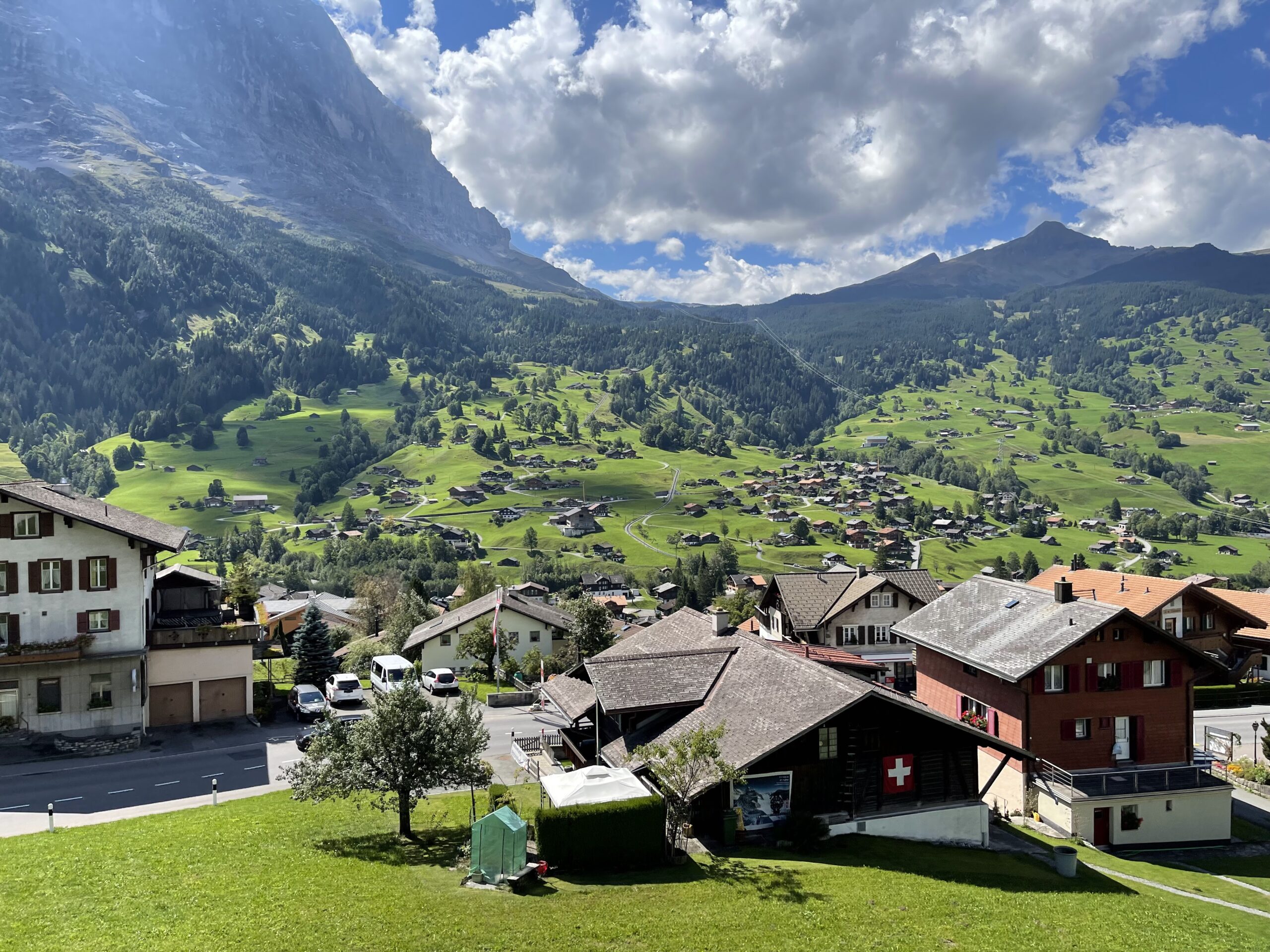
Switzerland Itinerary – A Journey Through Scenic Wonders and Timeless Charm
Switzerland, a country known for its stunning alpine landscapes, crystal-clear lakes, and charming medieval villages, offers a perfect blend of natural beauty and rich culture.
